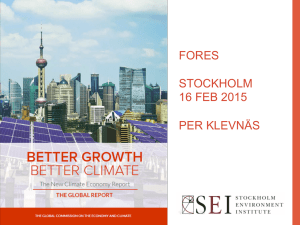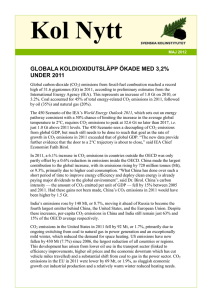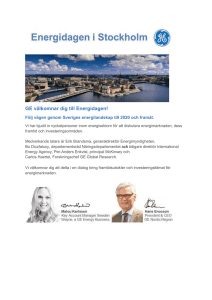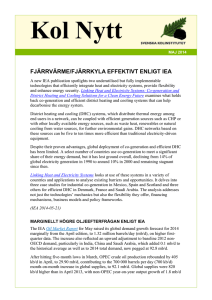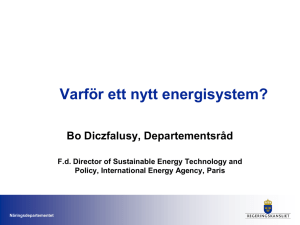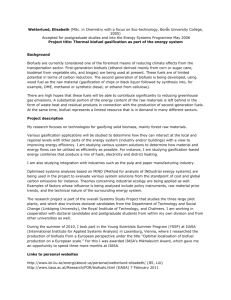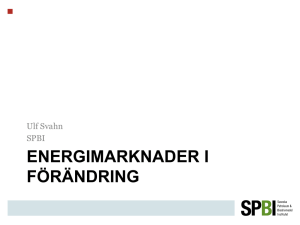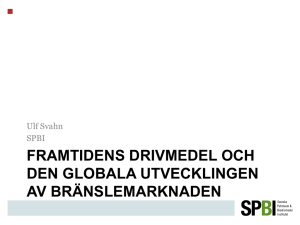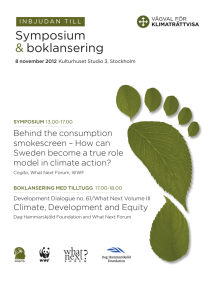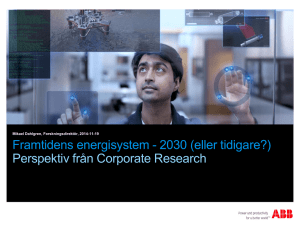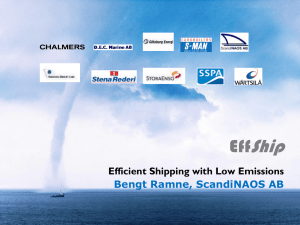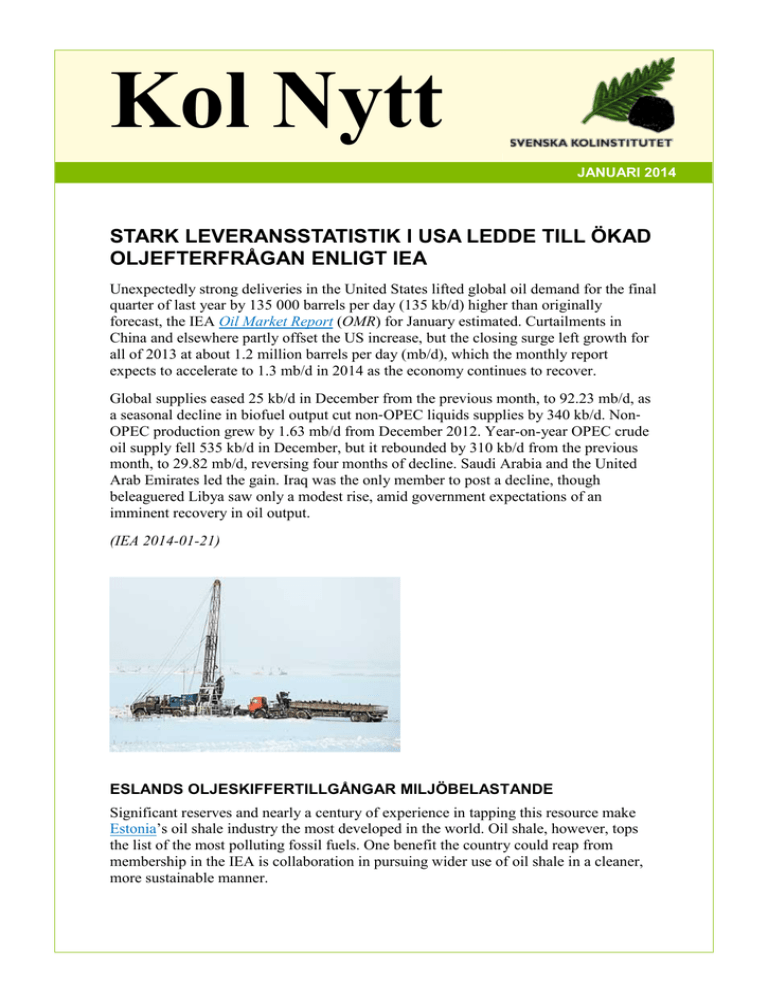
Kol Nytt
JANUARI 2014
STARK LEVERANSSTATISTIK I USA LEDDE TILL ÖKAD
OLJEFTERFRÅGAN ENLIGT IEA
Unexpectedly strong deliveries in the United States lifted global oil demand for the final
quarter of last year by 135 000 barrels per day (135 kb/d) higher than originally
forecast, the IEA Oil Market Report (OMR) for January estimated. Curtailments in
China and elsewhere partly offset the US increase, but the closing surge left growth for
all of 2013 at about 1.2 million barrels per day (mb/d), which the monthly report
expects to accelerate to 1.3 mb/d in 2014 as the economy continues to recover.
Global supplies eased 25 kb/d in December from the previous month, to 92.23 mb/d, as
a seasonal decline in biofuel output cut non‐OPEC liquids supplies by 340 kb/d. Non‐
OPEC production grew by 1.63 mb/d from December 2012. Year-on-year OPEC crude
oil supply fell 535 kb/d in December, but it rebounded by 310 kb/d from the previous
month, to 29.82 mb/d, reversing four months of decline. Saudi Arabia and the United
Arab Emirates led the gain. Iraq was the only member to post a decline, though
beleaguered Libya saw only a modest rise, amid government expectations of an
imminent recovery in oil output.
(IEA 2014-01-21)
ESLANDS OLJESKIFFERTILLGÅNGAR MILJÖBELASTANDE
Significant reserves and nearly a century of experience in tapping this resource make
Estonia’s oil shale industry the most developed in the world. Oil shale, however, tops
the list of the most polluting fossil fuels. One benefit the country could reap from
membership in the IEA is collaboration in pursuing wider use of oil shale in a cleaner,
more sustainable manner.
Kol Nytt JANUARI 2014
Not to be confused with shale oil, oil shale is a sedimentary rock containing up to 50%
organic matter rich in hydrogen, known as kerogen. The extracted rock can be used
directly as a power plant resource or it can be processed to produce shale oil, which in
turn can be refined into gasoline, diesel or jet fuels.
Estonia’s oil shale is energy-rich, but its direct combustion, or transformation into shale
oil and then other fuels, emits more CO2 than any other primary fuel.
(IEA 2014-01-02)
EUS KLIMAT- OCH ENERGIMÅL FÖR ÅR 2030
A reduction in greenhouse gas (GHG) emissions by 40% below the 1990 level, an EUwide binding target for renewable energy of at least 27%, renewed ambitions for energy
efficiency policies, a new governance system and a set of new indicators to ensure a
competitive and secure energy system. These are the pillars of the new EU framework
on climate and energy for 2030 presented today by the European Commission.
Supported by a detailed analysis on energy prices and costs, the 2030 framework will
ensure regulatory certainty for investors and a coordinated approach among Member
States, leading to the development of new technologies. The framework aims to drive
continued progress towards a low-carbon economy and a competitive and secure energy
system that ensures affordable energy for all consumers, increases the security of the
EU’s energy supplies, reduces our dependence on energy imports and creates new
opportunities for growth and jobs, by taking into account potential price impacts on the
longer term.
The Communication setting out the 2030 framework will be debated at the highest level,
in particular in the European Council and European Parliament. It is accompanied by a
legislative proposal for a market stability reserve for the EU emissions trading system
(EU ETS) starting in 2021, to improve its robustness. A report on energy prices and
costs in Europe, published alongside the Communication, suggests that the rising energy
prices can be partly mitigated by ensuring cost effective energy and climate policies,
competitive energy markets and improved energy efficiency.
(EU 2014-01-22)
EU-KOMMISSIONEN TILLKÄNNAGER FÖRSLAG TILL MINIMIREGLER VID
SKIFFERGASUTVINNING
Today the European Commission adopted a Recommendation aiming to ensure that
proper environmental and climate safeguards are in place for "fracking" – the highvolume hydraulic fracturing technique used notably in shale gas operations. The
Recommendation should help all Member States wishing to use this practice address
health and environmental risks and improve transparency for citizens. It also lays the
2
Kol Nytt JANUARI 2014
ground for a level playing field for industry and establishes a clearer framework for
investors.
The Recommendation is accompanied by a Communication that considers the
opportunities and challenges of using "fracking", to extract hydrocarbons. Both
documents are part of a wider initiative by the Commission to put in place an integrated
climate and energy policy framework for the period up to 2030.
(EU 2014-01-22)
EU-KOMMISSIONENS FÖRSLAG OM ÄNDRINGAR I
UTSLÄPPSHANDELSSYSTEMET GODKÄNT
The European Commission welcomes today's vote by EU governments gathered in the
Climate Change Committee to postpone the sale of 900 million carbon allowances in
the 3rd phase of the EU's Emissions Trading System (EU ETS) which runs up to 2020.
This marks a key step in restoring the short term balance in the European carbon market
and sets the stage for the proposal of a further structural measure shortly.
Welcoming the vote, Climate Action Commissioner Connie Hedegaard said: ''Backloading is now a reality, and the Commission hopes that the first allowances can be
back-loaded very soon. But while back-loading will help stabilise the carbon market in
the coming years, we must also tackle the more structural challenges. The Commission
will address these when it proposes the 2030 climate and energy framework later this
month."
(EU 2014-01-08)
VATTENFALLS CHEF OM EUS ENERGI- OCH KLIMATMÅL
År 2007 fastställde EU de klimatmål som ska uppnås till 2020: 20 % förnybar energi, 20
% mindre koldioxidutsläpp, 20 % högre energieffektivitet. Nu läggs ett förslag fram om
hur Europas klimatmål ska definieras för nästa årtionde, det vill säga fram till 2030, och
vad det skulle innebära för energibranschen.
Vattenfalls koncernchef Øystein Løseth hoppas att det europeiska ramverket kommer att
driva fram en bättre fungerande intern energimarknad:
– Riktlinjer om klimat, förnybar energi och energieffektivitet måste vara mycket mer
samordnade i framtiden, säger han.
Øystein Løseth är särskilt angelägen om att handeln med utsläppsrätter ska stärkas:
– Jag anser att priset på koldioxid ska vara den huvudsakliga sporren för att minska
koldioxidutsläppen. Om EU:s handel med utsläppsrätter, ETS-systemet, stärks så får
alla intressenter en tydlig signal om vilken riktning man bör röra sig i för att nå
klimatmålen. Koldioxidpriserna stimulerar både en ökad användning av förnybar energi
och energieffektivitet, säger Øystein Løseth.
(Vattenfall 2014-01-22)
3
Kol Nytt JANUARI 2014
RAPPORT FRÅN AMERICAN COALITION FOR CLEAN COAL
ELECTRICITY
The report highlights that coal is the world’s fastest growing energy source and has
increased nearly as much as all other sources of fuel combined. Much of this growth is
in emerging economies like China and India, which are just beginning to realise the
social and economic benefits that reliable, affordable electricity can bring. It is expected
that coal will continue to be the leading feedstock for electricity generation around the
globe for at least the next three decades.
In the US, coal remains the largest feedstock for baseload electricity generation,
supplying nearly 40% of the nation’s electricity. However, the US Environmental
Protection Agency (EPA) is making it increasingly difficult for clean coal energy to
survive in the US. The EPA’s proposed rule for new coal-fired power plants, the New
Source Performance Standard (NSPS), has been widely criticised for its unachievable
requirements. NSPS requires the use of carbon capture and storage (CCS) for all new
coal-fuelled power plants, a technology not yet commercially viable. The EPA proposal
effectively bans new coal plants.
(World Coal Association 2014-01-24)
EUS ENERGIKOSTNADER MER ÄN DUBBELT SÅ HÖGA SOM DE I USA
Enligt en EU-rapport ökar skillnaderna i energikostnader mellan Europa och USA.
Industrins elkostnader i Europa är mer än dubbelt så höga som de i USA och 30 %
högre än de i Kina. Industrins gaskostnader är tre till fyra gånger högre i Europa än i
USA eller Ryssland och 12 % högre än gaskostnaderna i Kina enligt rapporten.
Chefen för stålföretaget Arcelor-Mittal säger att om företagets anläggningar inom EU
hade amerikanska energipriser kostnaderna per år skulle vara mer än en miljard dollar
lägre.
(FiT 2014-01-21)
ENERGIKOSTNADSSKILLNADERNA MELLAN USA OCH EUROPA KAN
BESTÅ UNDER 20 ÅR ENLIGT IEA
Höga el- och gaskostnader kan skada konkurrenskraften hos europeisk industri under 20
år enligt en analys av IEA. Detta kan leda till att europeiska företag tappar en tredjedel
av sin marknadsandel för energiintensiv export. Det är inte bara miljöpolitiken som höjt
energipriserna i Europa men energiprisgapet mellan USA och Europa kan förväntas
bestå under en mycket längre period än tidigare förväntat. Skillnaden är strukturell inte
några engångseffekter enligt IEA. Frågans betydelse har inte uppmärksammats i Europa
och osäkerheter skapas för de 30 miljoner anställda inom järn-, stål- och kemi-industrin
i Europa.
(FiT 2014-01-30)
4
Kol Nytt JANUARI 2014
INTE PEAK OIL MEN PEAK OLJEEFTERFRÅGAN?
Oljemarknadsanalytiker avfärdar i ökande grad att tillgångssidan skulle utgöra en
begränsande faktor för oljanvändningen i världen. Däremot tror man att peak demand
för olja kan inträffa inom fem år. Efterfrågan på olja på mogna marknader som USA,
EU och Japan har kanske redan nått sitt strukturella maximum på grund av
energieffektivisering och möjligheterna att ersätta olja med naturgas. Detta kommer att
leda till minskad efterfrågan på olja. Enligt USAs energiadministration var
oljeanvändningen i USA för perioden 2005-2008 i genomsnitt 20,5 miljoner fat per dag
för att under perioden 2009-2012 minska med 1,7 miljoner fat i genomsnitt per dag till
18,8 miljoner fat. Men frågan är om denna minskning är strukturell eller
konjunkturberoende eftersom oljeanvändningen i USA ökade under 2013. Ytterligare
data visar att efterfrågeminskningen sannolikt är konjunkturell och inte strukturell så
peak demand sannolikt inte är en begränsande faktor, däremot kan bestående höga
oljepriser på grund av allt högre utvinningskostnader bli allt viktigare i bedömningen av
oljemarknaden och dess utveckling.
(FiT 2014-01-14)
ÄVEN ITALIENSKA ENI LÄMNAR SINA SKIFFERGASPROJEKT I POLEN
ENI följer ExxonMobil, Marathon Oil och Talisman Energy och lämnar försöken att
utvinna skiffergas i Polen. Av de stora oljebolagen fortsätter bara Chevron att söka efter
utvinningsbara tillgångar av skiffergas i landet. Den amerikanska energiadminstrationen
bedömde att det fanns stora skiffergastillgångar i Polen och detta ledde till att en mängd
prospekteringsprojekt drogs igång. Intresset för skiffergas i Europa flyttas nu till
Ukraina. Frankrike som bedöms ha skiffergastillgångar har av miljöskäl inte tillåtit
prospektering. Även Tyskland är tveksamt till eventuell utvinning. Däremot fortsätter
prospekteringsarbetet i Storbritannien.
(FiT 2014-01-16)
ÖKAD KOLANVÄNDNING FÖR ELPRODUKTION I TYSKLAND
Brunkolsanvändningen för elproduktion i Tyskland ökade 2013 till den högsta nivån
sedan 1990. Elproduktionen från brunkol ökade till 162 TWh 2013 jämfört med 161
TWh 2012. På grund av detta beräknas de tyska koldioxidutsläppen öka med 20 milj ton
till 951 milj ton 2013. Elproduktionen i Tyskland från förnybara energikällor uppgick
till 147 TWh 2013.
(FiT 2014-01-08)
AMERIKANSKA FÖRETAG INTRESSERADE ATT UTVINNA SKIFFERGAS I
KINA
Kina bedöms ha världens största tillgångar av skiffergas. Någon utvinning av betydelse
har inte påbörjats, men i Kina har man med stort intresse följt utvecklingen i USA. Alla
de stora internationella oljebolagen har ingått avtal med kinesiska partners om
prospektering och utvinning av skiffergas i landet.
(FiT 2014-01-08)
5
Kol Nytt JANUARI 2014
NYA REGLER FÖR JÄRNVÄGSTRANSPORTER AV OLJA I USA
Det snabbt ökande intresset för att transportera råolja med järnväg i USA har lett till
oroande olyckor och arbete har nu påbörjats på att skärpa reglerna för
järnvägstransporter av råolja. Boomen i utvinning av skifferolja och skiffergas ligger
bakom det ökade transportbehovet. Även sjötransporter mellan amerikanska hamnar av
bränslen har kraftigt ökat.
(FiT 2014-01-08)
FÖRLUSTER FÖR RYSKA STÅL- OCH GRUVFÖRETAGET MECHEL
Kokskolproducenten Mechel har drabbats av sänkta världsmarknadspriser och ökad
skuldsättning. Under de första nio månaderna av 2013 gjorde Mechel en nettoförlust på
2,2 miljarder dollar, mycket beroende på engångsnedskrivningar av tillgångar. Mechel
är en av världens sex största exportörer av kokskol. Mechel är ett av flera ryska
gruvföretag som har fått ekonomiska problem på grund av tidigare expansion genom
upplåning. Det stora ryska gruvföretaget Rusal har exempelvis en nettoskuld på
10 miljarder dollar.
(FiT 2013-12-31)
INDIENS KOLIMPORT ÖKADE 21 % UNDER 2013 JÄMFÖRT MED ÅRET
INNAN
India's coal imports rose 21 percent to 152 million tonnes last year as power producers
bought more due to low prices and a domestic shortage, research firm OreTeam said,
adding that shipments could rise to 170 million tonnes this year.
Bureaucratic, environmental and legal delays in adding new mines and expanding
existing ones have made India the No. 3 importer of coal, behind China and Japan, even
though it sits on what BP Plc (BP.L) ranks as the world's fifth-largest reserves.
Most of the imports come from Indonesia, South Africa, Australia and Canada. India
shipped in a total of 126 million tonnes of power-generating thermal coal, steelmaking
coking coal and processed coking coal, or metallurgical coal, in 2012.
"Rising thermal coal demand is the major reason behind India's surging imports," said
Prakash Duvvuri, head of research at OreTeam, which collects data from its
representatives at ports, mining regions and companies.
(Reuters 2014-01-22)
FINANSIERING AV AMERIKANSKT CCS-PRJEKT
A long-stalled project to capture carbon-dioxide emissions from a coal plant in Illinois
will get a $1 billion grant from the U.S. Department of Energy, which the operator said
will allow construction to begin this year.
The approval is “a boost to demonstrating fully integrated carbon capture and storage
technology at commercial-scale coal-fueled power plant,” Ken Humphreys, chief
6
Kol Nytt JANUARI 2014
executive of the FutureGen Alliance, said in a statement today. The full cost of the
project is $1.65 billion.
The Department of Energy issued its finding on the environmental review.
The decision came as Republican senators criticized the U.S. Environmental Protection
Agency for proposing to require all new coal plants to install carbon-capture equipment.
Technology industry advocates say that gear isn’t available yet on a commercial scale.
(Bloomberg 2014-01-16)
SMÅ FÖRVÄNTNINGAR PÅ GLOBALT KLIMATAVTAL NÄSTA ÅR
Any agreement that emerges from Paris next year will, most agree, look fundamentally
different from the 1997 Kyoto Protocol. That pact was abandoned by the U.S. Senate
because it imposed emissions cuts on wealthy countries but let developing nations -including China -- off the hook by allowing them to make voluntary cuts in exchange
for financial support. President George W. Bush declared Kyoto "dead," and since
President Obama entered office, his climate team's top goal has been to avoid the
mistakes of Kyoto.
That has meant steadily breaking down what U.S. Special Envoy for Climate Change
Todd Stern has called the "firewall" between developed and developing countries. Year
after year, starting in Copenhagen, Stern and his team have chipped away at that wall,
and what now remains are the outlines of a deal that -- at least on paper -- will see all
countries big and small cut carbon.
And yet the deal will also likely be looser. Kyoto was a legally binding agreement that
imposed and split up among rich nations a 5.2 percent global emissions cut from 1990
levels. With China now the world's largest emitter and other developing countries
booming, there is little appetite left among rich nations to continue in that top-down
vein. The United States is leading the charge for a voluntary pact in which countries
declare targets that are then enforced with monitoring and reporting efforts.
"Expectations at this stage are much more realistic than they were before Copenhagen,
and that's one of the reasons I'm hopeful," said Elliot Diringer, executive vice president
of the Center for Climate and Energy Solutions. He noted that the most recent U.N.
climate conference in Warsaw last year ended with a decision that countries should
announce their "nationally determined contributions" for cutting emissions in the post2020 era by early next year.
(Climate Wire 2014-01-14)
Magnus.grill@kolinstitutet.se
www.kolinstitutet.se
Svenska Kolinstitutet
Kungsbroplan 2
Box 1026
101 38 Stockholm
Tel 08-525 099 39
7

